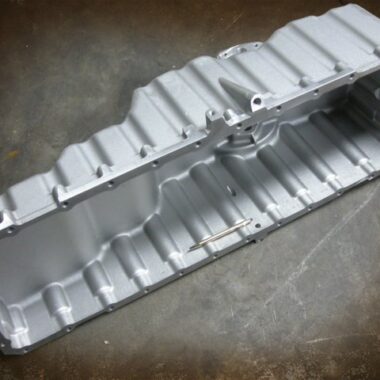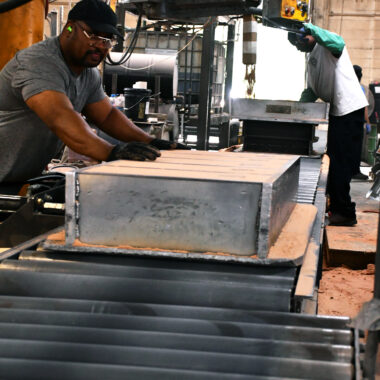Making The Most Of Performance: Procedures in Casting Aluminum Illinois
Wiki Article
The Art of Light Weight Aluminum Spreading: Enhancing Your Skills for Superior Results
Aluminum casting is a craft that demands precision, patience, and a deep understanding of the methods included. As designers and craftsmens, our search of quality in light weight aluminum spreading is a trip that needs commitment and a continual pursuit for proficiency.History of Aluminum Casting
Light weight aluminum casting, a process with beginnings mapping back centuries, has played a substantial function in the advancement of different markets. The history of light weight aluminum casting dates back to the 19th century when it emerged as a pivotal manufacturing strategy. The use of light weight aluminum in casting processes revolutionized sectors such as vehicle, aerospace, and construction due to its light-weight properties and deterioration resistance.One of the earliest uses of aluminum casting can be mapped to the production of cookware and attractive products. As improvements in technology took place, aluminum spreading broadened its reach to include engine parts, structural components for airplane, and intricate styles in architectural frameworks. The versatility and versatility of light weight aluminum casting enabled for the creation of detailed shapes and layouts that were previously unattainable with other manufacturing approaches.
Today, aluminum spreading continues to be a foundation of modern commercial processes, allowing the manufacturing of complicated components with high accuracy and efficiency (casting aluminum illinois). Comprehending the historic evolution of light weight aluminum casting supplies beneficial insights right into its long-lasting significance and continual development in the industrial landscape
Crucial Tools and Devices
Making use of specialized tools and equipment is vital in attaining ideal cause the light weight aluminum spreading process. The essential devices required for light weight aluminum spreading consist of a crucible for thawing the light weight aluminum, a heater to reach the needed temperature levels, and mold and mildews to form the molten metal. Crucibles, commonly made of graphite or ceramic materials, must endure heats to avoid contamination of the aluminum. Furnaces are essential for heating the aluminum to its melting factor, generally around 660 degrees Celsius, ensuring it remains in a fluid state for spreading. Molds are available in various types, such as sand mold and mildews or die-casting molds, to give the light weight aluminum its wanted form.
Safety equipment is important to prevent injuries from the high temperature levels involved in the casting procedure. Generally, having the right tools and devices is paramount for accomplishing premium and precise aluminum spreadings.
Mastering the Casting Process
Having actually acquired the necessary devices and equipment for aluminum spreading, the following action towards excellence depends on understanding the intricate casting process. casting aluminum illinois. The casting process entails a collection of actions that require interest, precision, and skill to detail to ensure superior results
When the light weight aluminum has actually strengthened, meticulously getting rid of the spreading from the mold without creating any damages is critical. Understanding each action of the spreading procedure informative post is vital to generating high-grade light weight aluminum spreadings.

Advanced Techniques and Tips
Understanding complex information and executing innovative techniques can raise the quality and accuracy of light weight aluminum spreading processes. One sophisticated strategy is using ceramic molds, which offer a smoother surface area coating and greater dimensional accuracy contrasted to standard sand mold and mildews. Additionally, employing vacuum spreading approaches can help in reducing porosity in the final casting, leading to more powerful and extra durable aluminum parts.One more pointer is to pre-heat the mold and mildews prior to putting the liquified aluminum to improve the flowability of read the full info here the metal and decrease the probability of problems such as cool shuts or misruns. In addition, utilizing chill blocks strategically can help regulate the solidification price of the light weight aluminum, minimizing internal tensions and enhancing the overall mechanical buildings of the actors component.
Finally, mastering the art of gating and risering is critical for attaining audio castings. Correctly designed gating risers and systems can aid prevent contraction defects and ensure an attire circulation of steel throughout the mold and mildew tooth cavity, resulting in superior casting top quality. By incorporating these advanced strategies and pointers into your aluminum casting procedure, you can improve the consistency and accuracy of your end products.
Troubleshooting Common Spreading Issues
Dealing with common casting concerns calls for a methodical approach to recognize and correct variables influencing the quality of light weight aluminum castings. One widespread problem is porosity, which causes tiny openings or voids in the spreading due to gas entrapment. This concern can be reduced by effectively degassing the liquified light weight aluminum before casting and ensuring appropriate venting in the mold. An additional common obstacle is shrinkage flaws, where the casting contracts erratically during air conditioning, resulting in splits or distortion. To deal with contraction, adjusting the gating system layout and optimizing the riser positioning can aid promote consistent solidification. In addition, improper mold dental filling can cause issues like misruns or chilly shuts, causing incomplete castings. Enhancing index the gating system, enhancing putting techniques, and making sure correct metal temperature level are critical in avoiding such defects. By comprehending these typical casting troubles and implementing effective options, light weight aluminum wheels can enhance the overall quality and stability of their spreadings.Final Thought
Finally, mastering the art of aluminum spreading calls for a deep understanding of the background, necessary tools, and progressed techniques associated with the procedure. By refining your skills and troubleshooting common casting problems, you can accomplish exceptional results in your spreading jobs. Continuous technique and devotion are crucial to enhancing your abilities and generating top notch aluminum spreadings.Grasping each step of the spreading process is key to generating premium aluminum spreadings.
Additionally, using vacuum spreading techniques can aid lower porosity in the final spreading, resulting in stronger and extra long lasting aluminum parts.
Addressing usual casting concerns requires an organized method to recognize and remedy factors influencing the quality of light weight aluminum castings. By comprehending these usual casting troubles and executing reliable solutions, light weight aluminum wheels can boost the general top quality and integrity of their spreadings.
By sharpening your skills and fixing typical casting problems, you can attain superior results in your spreading tasks.
Report this wiki page